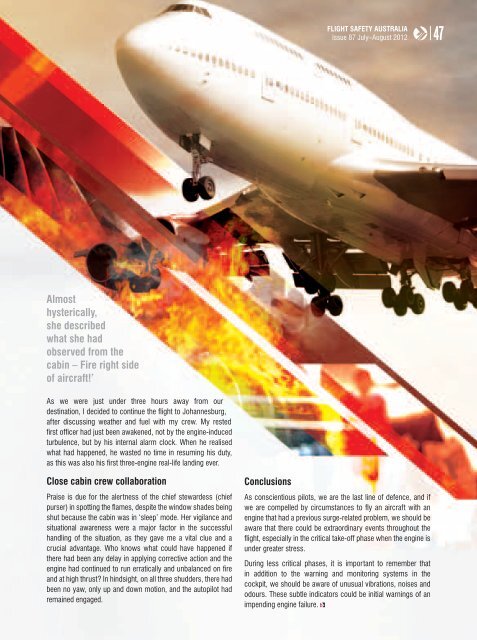jul-aug2012
You also want an ePaper? Increase the reach of your titles
YUMPU automatically turns print PDFs into web optimized ePapers that Google loves.
Flight Safety Australia<br />
Issue 87 July–August 2012<br />
47<br />
Almost<br />
hysterically,<br />
she described<br />
what she had<br />
observed from the<br />
cabin – Fire right side<br />
of aircraft!’<br />
As we were just under three hours away from our<br />
destination, I decided to continue the flight to Johannesburg,<br />
after discussing weather and fuel with my crew. My rested<br />
first officer had just been awakened, not by the engine-induced<br />
turbulence, but by his internal alarm clock. When he realised<br />
what had happened, he wasted no time in resuming his duty,<br />
as this was also his first three-engine real-life landing ever.<br />
Close cabin crew collaboration<br />
Praise is due for the alertness of the chief stewardess (chief<br />
purser) in spotting the flames, despite the window shades being<br />
shut because the cabin was in ‘sleep’ mode. Her vigilance and<br />
situational awareness were a major factor in the successful<br />
handling of the situation, as they gave me a vital clue and a<br />
crucial advantage. Who knows what could have happened if<br />
there had been any delay in applying corrective action and the<br />
engine had continued to run erratically and unbalanced on fire<br />
and at high thrust? In hindsight, on all three shudders, there had<br />
been no yaw, only up and down motion, and the autopilot had<br />
remained engaged.<br />
Conclusions<br />
As conscientious pilots, we are the last line of defence, and if<br />
we are compelled by circumstances to fly an aircraft with an<br />
engine that had a previous surge-related problem, we should be<br />
aware that there could be extraordinary events throughout the<br />
flight, especially in the critical take-off phase when the engine is<br />
under greater stress.<br />
During less critical phases, it is important to remember that<br />
in addition to the warning and monitoring systems in the<br />
cockpit, we should be aware of unusual vibrations, noises and<br />
odours. These subtle indicators could be initial warnings of an<br />
impending engine failure.

















